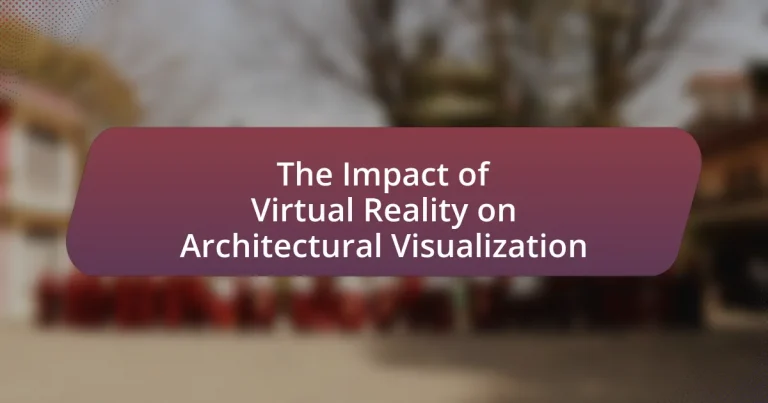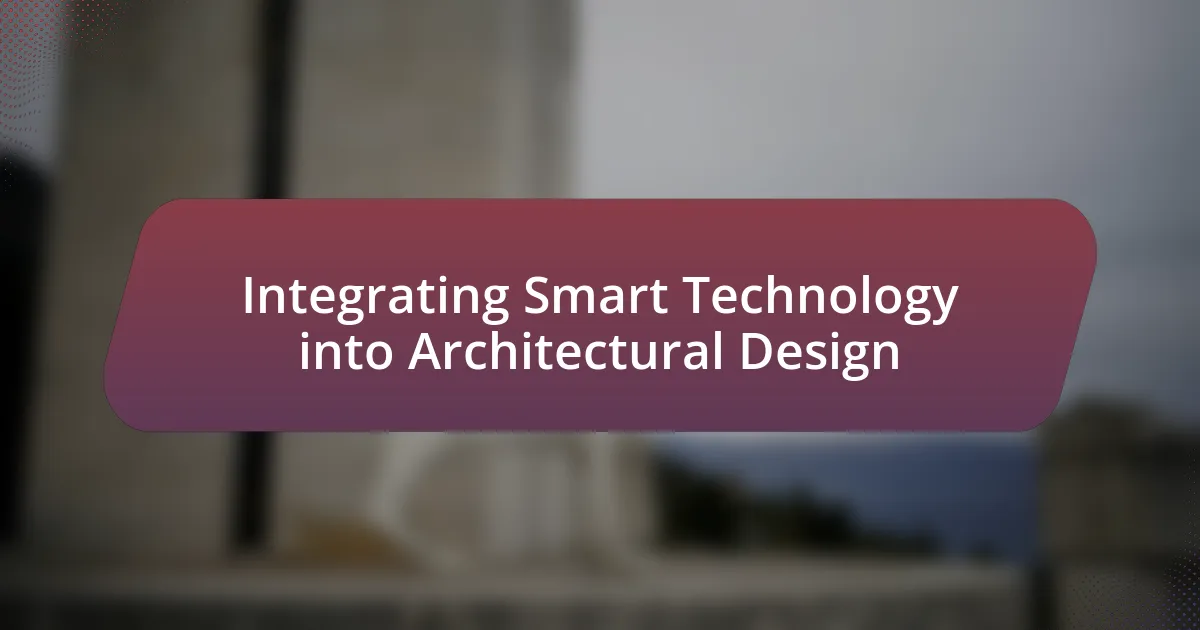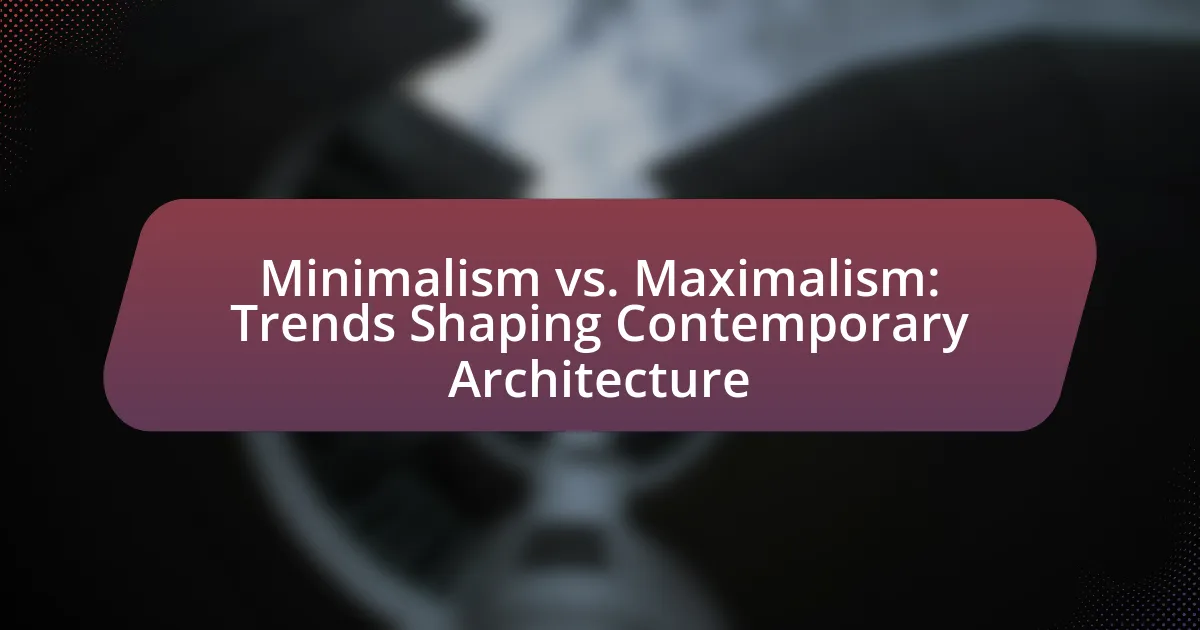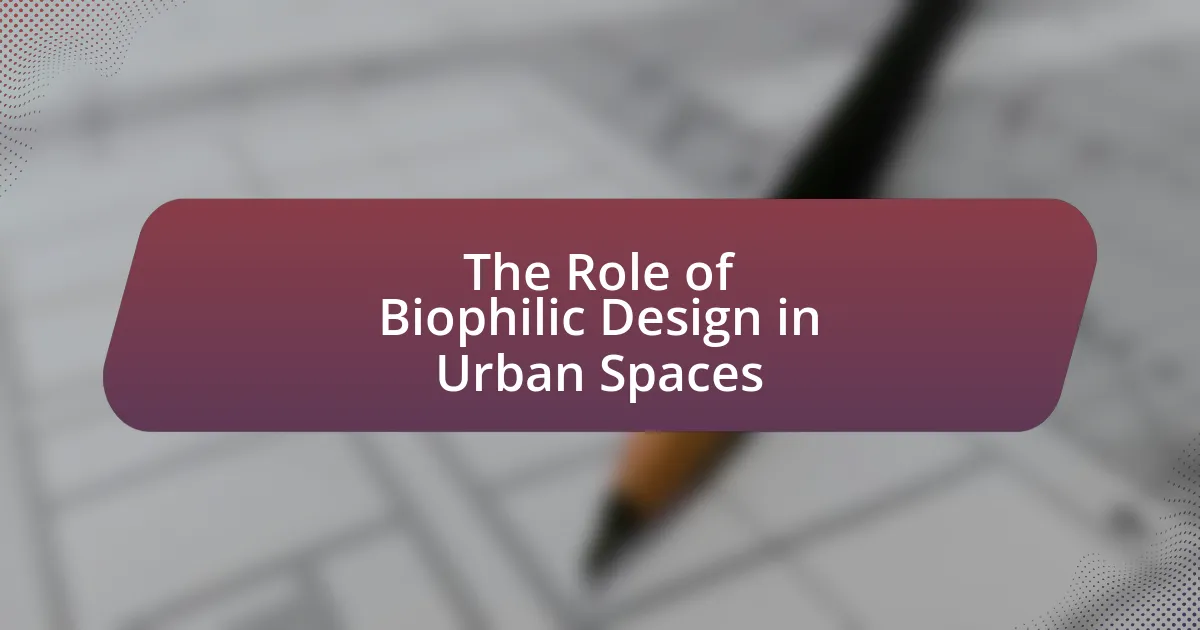The article examines the transformative impact of Virtual Reality (VR) on architectural visualization, highlighting its role in enhancing design accuracy, client engagement, and communication among stakeholders. It discusses how VR allows architects and clients to immerse themselves in 3D environments, leading to improved understanding of spatial relationships and reduced design errors by up to 30%. Key benefits include enhanced spatial understanding, real-time feedback, and the ability to identify design flaws early in the process. The article also addresses challenges such as high costs and technical limitations, while exploring future trends and emerging applications that could further benefit architectural practices.
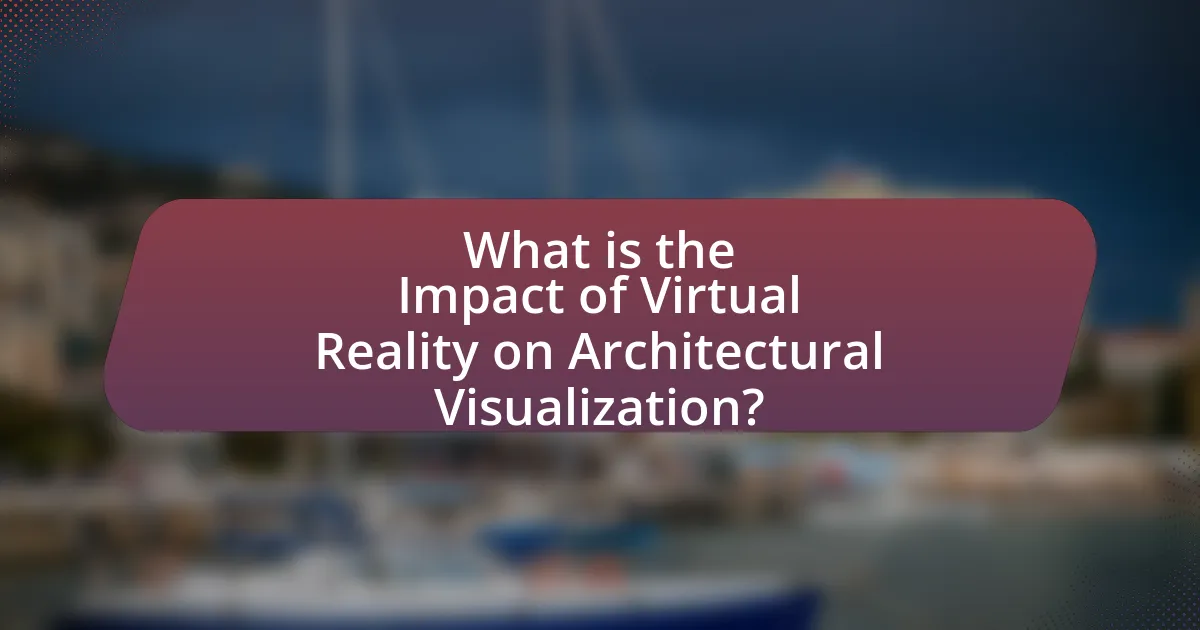
What is the Impact of Virtual Reality on Architectural Visualization?
The impact of virtual reality on architectural visualization is transformative, enhancing the design process and client engagement. Virtual reality allows architects and clients to immerse themselves in 3D environments, facilitating a more intuitive understanding of spatial relationships and design elements. Studies indicate that using virtual reality can reduce design errors by up to 30%, as it enables real-time modifications and immediate feedback during the design phase. Furthermore, a survey by the American Institute of Architects found that 70% of architects believe virtual reality improves client presentations, leading to higher satisfaction and more informed decision-making.
How does Virtual Reality enhance the architectural design process?
Virtual Reality enhances the architectural design process by allowing architects to create immersive, interactive environments that facilitate better visualization and understanding of designs. This technology enables stakeholders to experience a building before it is constructed, leading to improved decision-making and collaboration. Studies have shown that using Virtual Reality can reduce design errors by up to 30%, as it allows for real-time feedback and adjustments during the design phase. Additionally, Virtual Reality can enhance client engagement, as clients can navigate through spaces and provide input, ensuring that the final design aligns with their vision and requirements.
What specific features of Virtual Reality contribute to improved design accuracy?
Virtual Reality (VR) enhances design accuracy through features such as immersive visualization, real-time interaction, and spatial awareness. Immersive visualization allows designers and clients to experience a project in a 3D environment, leading to better understanding and identification of design flaws. Real-time interaction enables immediate modifications, allowing for instant feedback and adjustments, which significantly reduces errors. Spatial awareness is improved as users can navigate and assess dimensions and proportions accurately, leading to more precise design outcomes. Studies have shown that using VR in architectural design can reduce design errors by up to 30%, demonstrating its effectiveness in enhancing accuracy.
How does Virtual Reality facilitate client engagement during the design phase?
Virtual Reality (VR) enhances client engagement during the design phase by providing immersive, interactive experiences that allow clients to visualize and interact with designs in a realistic environment. This technology enables clients to explore spaces, make real-time adjustments, and provide immediate feedback, which fosters a collaborative design process. Studies show that VR can increase client satisfaction and understanding of design concepts, as it allows for a more tangible representation of architectural plans compared to traditional 2D drawings or models. For instance, a study published in the Journal of Architectural and Planning Research found that clients using VR reported a 70% increase in their ability to comprehend spatial relationships and design elements, leading to more informed decision-making.
What are the key benefits of using Virtual Reality in architectural visualization?
The key benefits of using Virtual Reality in architectural visualization include enhanced spatial understanding, improved client engagement, and the ability to identify design flaws early in the process. Enhanced spatial understanding allows architects and clients to experience designs in a 3D environment, making it easier to visualize scale and proportions. Improved client engagement occurs as users can interact with the design, leading to more informed feedback and decision-making. Additionally, the ability to identify design flaws early is supported by studies showing that VR can reduce costly changes during construction by up to 30%, as it allows for real-time adjustments and evaluations before physical implementation.
How does Virtual Reality improve communication among stakeholders?
Virtual Reality (VR) improves communication among stakeholders by providing immersive, interactive environments that facilitate real-time collaboration and visualization of architectural projects. This technology allows stakeholders, including architects, clients, and contractors, to experience designs in a three-dimensional space, enhancing understanding and reducing misinterpretations. Research indicates that VR can increase engagement and feedback quality, as users can navigate and manipulate virtual models, leading to more informed decision-making. For instance, a study by Kensek and Noble (2014) demonstrated that VR applications in architecture significantly improved stakeholder satisfaction and communication efficiency by allowing for immediate visual feedback and collaborative discussions.
What cost savings can be achieved through the use of Virtual Reality in architecture?
The use of Virtual Reality (VR) in architecture can achieve significant cost savings by reducing design errors and enhancing client communication. By allowing architects and clients to visualize projects in a 3D immersive environment, VR minimizes the likelihood of costly changes during construction. A study by the University of Southern California found that VR can reduce design errors by up to 30%, leading to savings in both time and materials. Additionally, VR facilitates better stakeholder engagement, which can decrease the number of revisions needed, further lowering project costs.

How is Virtual Reality transforming traditional architectural practices?
Virtual Reality (VR) is transforming traditional architectural practices by enabling immersive visualization and interactive design processes. Architects can create realistic 3D environments that clients can explore, allowing for immediate feedback and adjustments. This shift enhances collaboration among stakeholders, as VR facilitates a shared understanding of spatial relationships and design intent. Studies indicate that using VR in architectural design can reduce project costs by up to 30% and improve client satisfaction by providing a more engaging experience.
What changes are occurring in the workflow of architects due to Virtual Reality?
Virtual Reality (VR) is transforming the workflow of architects by enabling immersive design experiences and enhancing client engagement. Architects can now create and visualize projects in a 3D environment, allowing for real-time modifications and immediate feedback during the design process. This shift reduces the reliance on traditional 2D drawings and models, streamlining communication with clients and stakeholders. Studies indicate that using VR can increase design accuracy and client satisfaction, as clients can better understand spatial relationships and design intent. Additionally, VR facilitates collaborative design sessions, allowing multiple stakeholders to interact with the virtual model simultaneously, which fosters a more inclusive design process.
How does Virtual Reality influence the decision-making process in architecture?
Virtual Reality (VR) significantly enhances the decision-making process in architecture by providing immersive visualizations that allow architects and clients to experience designs in a realistic environment. This technology enables stakeholders to interact with 3D models, facilitating better understanding and communication of spatial relationships and design elements. Research by Kensek and Noble (2014) in “Building Information Modeling: BIM in Current and Future Practice” indicates that VR can reduce design errors and improve client satisfaction by allowing for real-time feedback and adjustments during the design phase. Consequently, the integration of VR into architectural workflows leads to more informed decisions, ultimately resulting in designs that better meet client needs and project requirements.
What role does Virtual Reality play in project presentations and marketing?
Virtual Reality (VR) enhances project presentations and marketing by providing immersive experiences that engage audiences more effectively than traditional methods. This technology allows potential clients to visualize architectural designs in a realistic 3D environment, facilitating better understanding and emotional connection to the project. Studies indicate that VR can increase retention rates of information by up to 70%, compared to 10% for standard presentations. Additionally, VR enables interactive elements, allowing users to explore spaces at their own pace, which can lead to higher conversion rates in marketing efforts.
How are architects adapting to the integration of Virtual Reality technologies?
Architects are adapting to the integration of Virtual Reality (VR) technologies by incorporating immersive design tools that enhance client engagement and streamline the design process. This adaptation allows architects to create realistic 3D environments where clients can experience spaces before they are built, facilitating better decision-making and feedback. For instance, firms like Gensler and Zaha Hadid Architects have successfully utilized VR to present designs, enabling clients to navigate virtual spaces and visualize architectural elements in real-time. This shift not only improves communication but also reduces costly revisions during the construction phase, as evidenced by a study from the University of Southern California, which found that VR can decrease design errors by up to 30%.
What skills do architects need to effectively utilize Virtual Reality?
Architects need technical proficiency in 3D modeling software, an understanding of virtual reality (VR) technology, and strong spatial awareness to effectively utilize Virtual Reality. Mastery of software such as Autodesk Revit or SketchUp allows architects to create detailed models that can be transformed into immersive VR experiences. Familiarity with VR hardware and software, including headsets and rendering engines, is essential for integrating these technologies into their workflow. Additionally, spatial awareness enables architects to visualize and manipulate designs in a three-dimensional space, enhancing the user experience in VR environments. These skills collectively empower architects to create compelling and interactive architectural visualizations that improve client engagement and design understanding.
How are educational institutions incorporating Virtual Reality into architectural curricula?
Educational institutions are incorporating Virtual Reality (VR) into architectural curricula by integrating immersive design tools that enhance spatial understanding and visualization skills. For instance, universities like the University of Southern California and the University of Michigan have adopted VR platforms to allow students to create and interact with 3D models of their designs in real-time. This hands-on experience facilitates a deeper comprehension of architectural concepts and design principles, as students can explore their projects from various perspectives and scales. Research indicates that such immersive learning environments improve student engagement and retention of complex architectural ideas, demonstrating the effectiveness of VR in educational settings.

What challenges does the adoption of Virtual Reality present in architectural visualization?
The adoption of Virtual Reality (VR) in architectural visualization presents several challenges, including high costs, technical limitations, and user experience issues. High costs stem from the need for advanced hardware and software, which can be prohibitive for smaller firms. Technical limitations include the requirement for significant computational power to render high-quality VR environments, which can lead to performance issues. User experience challenges arise from the need for intuitive interfaces and the potential for motion sickness among users, which can hinder effective engagement with the virtual environment. These factors collectively impact the widespread implementation of VR in architectural visualization.
What technical limitations exist with current Virtual Reality technologies?
Current Virtual Reality technologies face several technical limitations, including hardware constraints, motion sickness, and limited field of view. Hardware limitations, such as processing power and battery life, restrict the complexity and duration of VR experiences. Motion sickness arises from latency and mismatched sensory inputs, affecting user comfort and immersion. Additionally, many VR headsets have a restricted field of view, typically around 100 degrees, which can hinder the sense of presence and realism in virtual environments. These limitations impact the effectiveness of VR in applications like architectural visualization, where high fidelity and user comfort are crucial for accurate representation and engagement.
How do hardware and software costs impact the adoption of Virtual Reality in architecture?
Hardware and software costs significantly impact the adoption of Virtual Reality (VR) in architecture by creating financial barriers for firms. High-quality VR systems require expensive hardware, such as powerful computers and specialized headsets, which can exceed several thousand dollars. Additionally, software licenses for VR applications can also be costly, often requiring ongoing subscriptions or updates. According to a report by the International Data Corporation, the total cost of ownership for VR technology can deter smaller architectural firms from investing, limiting the widespread use of VR in the industry. Consequently, these financial constraints can slow down the integration of VR into architectural practices, affecting innovation and competitiveness.
What are the common user experience issues faced in Virtual Reality applications?
Common user experience issues faced in Virtual Reality applications include motion sickness, user interface complexity, and limited spatial awareness. Motion sickness occurs due to a disconnect between visual motion and physical movement, affecting approximately 40% of users, as reported in studies on VR discomfort. User interface complexity can overwhelm users, making navigation and interaction difficult, which is particularly problematic in architectural visualization where intuitive design is crucial. Limited spatial awareness arises when users cannot accurately perceive their surroundings, leading to disorientation and a diminished sense of presence, which can hinder the effectiveness of VR in architectural contexts.
How can architects overcome the challenges of implementing Virtual Reality?
Architects can overcome the challenges of implementing Virtual Reality by investing in training and adopting user-friendly VR technologies. Training ensures that architects are proficient in VR tools, which enhances their ability to create immersive experiences. User-friendly technologies, such as software with intuitive interfaces and hardware that is easy to use, reduce the learning curve and increase adoption rates. For instance, a study by the American Institute of Architects found that firms that provided VR training saw a 30% increase in project efficiency, demonstrating the effectiveness of these strategies in overcoming implementation challenges.
What best practices should be followed for successful Virtual Reality integration?
Successful Virtual Reality integration requires a clear understanding of user experience, technical capabilities, and project objectives. First, prioritize user-centered design by involving end-users in the development process to ensure the VR experience meets their needs and expectations. Second, ensure compatibility with existing hardware and software systems to facilitate seamless integration; for instance, using widely adopted platforms like Unity or Unreal Engine can enhance accessibility. Third, maintain high-quality graphics and performance standards, as studies show that immersive experiences significantly improve user engagement and retention. Lastly, provide comprehensive training and support for users to maximize the effectiveness of the VR tools, as evidenced by research indicating that proper training increases user satisfaction and proficiency.
How can collaboration with technology providers enhance Virtual Reality adoption?
Collaboration with technology providers can significantly enhance Virtual Reality (VR) adoption by facilitating access to advanced tools and resources that improve user experience and application development. By partnering with specialized technology firms, organizations can leverage cutting-edge hardware and software solutions tailored for VR, which can lead to more immersive and effective architectural visualizations. For instance, companies like NVIDIA and Oculus have developed powerful graphics processing units and VR headsets that enable high-quality rendering and realistic simulations, making VR more appealing to architects and clients alike. This collaboration not only accelerates the development of VR applications but also ensures that users have access to the latest innovations, ultimately driving broader acceptance and integration of VR in architectural practices.
What are the future trends of Virtual Reality in architectural visualization?
The future trends of Virtual Reality in architectural visualization include increased interactivity, enhanced realism, and integration with artificial intelligence. Increased interactivity allows clients to engage with designs in real-time, facilitating better decision-making and feedback. Enhanced realism is achieved through advancements in graphics technology, enabling lifelike representations of materials and lighting. Integration with artificial intelligence streamlines design processes by automating tasks such as generating design alternatives and optimizing layouts based on user preferences. These trends are supported by the growing adoption of VR technologies in the architecture industry, with a report from Statista indicating that the global VR market in architecture is projected to reach $1.5 billion by 2025, reflecting a significant increase in investment and application.
How might advancements in Virtual Reality technology shape architectural design in the next decade?
Advancements in Virtual Reality technology will significantly enhance architectural design by enabling immersive visualization and real-time interaction with 3D models. This technology allows architects and clients to experience designs in a fully immersive environment, facilitating better understanding and communication of spatial relationships and design intent. For instance, tools like Oculus Rift and HTC Vive have already demonstrated the capability to simulate real-world environments, allowing users to walk through and interact with designs before construction begins. This immersive experience can lead to more informed decision-making, reducing costly changes during the building process. Additionally, VR can streamline collaboration among stakeholders by providing a shared virtual space for discussions and modifications, ultimately leading to more innovative and user-centered architectural solutions.
What emerging applications of Virtual Reality could further benefit architects?
Emerging applications of Virtual Reality (VR) that could further benefit architects include immersive design reviews, real-time collaboration, and enhanced client presentations. Immersive design reviews allow architects to visualize and interact with their designs in a 3D space, facilitating better understanding and identification of design flaws before construction. Real-time collaboration enables multiple stakeholders, including clients and engineers, to engage in the design process simultaneously, improving communication and decision-making. Enhanced client presentations leverage VR to create realistic walkthroughs of projects, helping clients visualize the final outcome and providing immediate feedback. These applications are supported by advancements in VR technology, such as improved rendering capabilities and more accessible hardware, which make these experiences more feasible and effective in architectural practice.
What practical tips can architects follow to maximize the benefits of Virtual Reality?
Architects can maximize the benefits of Virtual Reality (VR) by integrating immersive design reviews into their workflow. This approach allows architects to visualize and interact with their designs in a three-dimensional space, enhancing understanding and communication with clients and stakeholders. Utilizing VR tools like Oculus Rift or HTC Vive enables real-time modifications, which can lead to more informed decision-making and reduced design errors. Research indicates that immersive environments improve spatial awareness and design comprehension, as evidenced by a study published in the Journal of Architectural Education, which found that 85% of participants felt more engaged with designs presented in VR compared to traditional methods.
